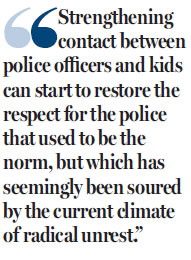Boost our young people's respect for police and the law
Updated: 2016-02-23 08:56
By Jon Lowe(HK Edition)
|
|||||||||
Condemnation of the Mong Kok riots has been relentless, and understandably so. Many people's anger has been fired by imagining themselves in the boots of the police officers who had to deal with the disturbance. Police, especially those present at the initial stages of the riot, suffered many injuries, some serious. One suffered fractures to his cheekbones and skull, and needed nearly 30 stitches in his face. In a sad irony, this officer was part of a unit tasked with improving communication with young people. One can only hope that both his health and morale can be restored sufficiently for him to resume this vital task.
Many YouTube videos bear witness to the mayhem. One video consists of a single shot that tracks a mob advancing on a squad of traffic cops and other police without riot gear hastily drafted in as back-up - including the community relations team member mentioned above - while a hurricane of missiles such as wooden pallets, trash bins, sticks, bricks and bottles fly at the officers. The video culminates with the now notorious moment when an officer hits the ground and is repeatedly assaulted, followed by the sound of two gunshots, whereupon the camera swings around to dramatically zoom in on an officer restraining the arm of a colleague with his sidearm drawn until he holsters it. From this brutally eloquent footage alone - never mind the hours and hours of other footage posted - there is no mistaking the traumatic effect of the violence on the police.
It is worrying to see so much rage directed against the police in Hong Kong. They certainly do not deserve it. Such anti-police sentiment can easily get out of hand. During one flare-up in Tottenham, London in the UK in the 1980s, it was discovered that rioters had planned to lure police into an underground car park which had been filled with tires and other toxic debris and drenched with gasoline. From grievances about poverty and inequality, a number of gangsters had transformed the riot into a form of human blood sport by dreaming up a plan to try and incinerate or suffocate as many police officers as they could.
Things have not got that bad in Hong Kong - yet. This is cause for some optimism, as is the absence of looting, which was such a prominent feature of the UK riots in 2011. But this reckless behavior must be nipped in the bud for two reasons - to preserve the peace, obviously, but also to maintain Hong Kong's civil liberties. The prospect of more violent disturbances is only likely to cause the authorities to increase video surveillance on the streets as well as online surveillance, and imposing more stringent controls on public gatherings. This is without even mentioning how the rise of separatism in the SAR will affect national security policy. Apart from the expression of mob misrule, Hong Kong people should be furious with the rioters because they have directly threatened our civil liberties.
These rioters have displayed a new dark and destructive cancer among Hong Kong's protesting youth. So dark, in fact, that other more moderate radicals cannot even believe that the rioters were ordinary Hong Kong youths, claiming they must have been agents provocateur deployed to stir up trouble and bring about the curtailments of civil liberties. But of course, this does not stand the test of logic - like most conspiracy theories - since at least a few such agents could not have escaped being arrested and unmasked. (Of course, to some people's minds, the police were no doubt in on the conspiracy anyway and were quite happy to be repeatedly assaulted with bricks and other lethal projectiles in furtherance of some nefarious plan to destabilize Hong Kong and make their jobs 10 times harder!)
It is probably too late to change the attitudes of the Mong Kok rioters. But our educators can play a part in helping those still in school to understand the twin dangers to peace and liberty inherent in hatred of the police, as well as help eradicate the festering violent inclinations that now seem to haunt society. Riot footage like that described above should be screened in schools and debated on - perhaps with the presence of police officers to humanize their role and answer students' questions about the reality of dealing with such trying circumstances. This would enable students to properly assess the dishonorable nature of lethal aggression against the force tasked with preserving our safety - a force which undoubtedly has been doing a good job for many years. Strengthening contact between police officers and kids can start to restore the respect for the police that used to be the norm, but which has seemingly been soured by the current climate of radical unrest.
The author is a seasoned journalist who has worked in many places in the world.

(HK Edition 02/23/2016 page9)